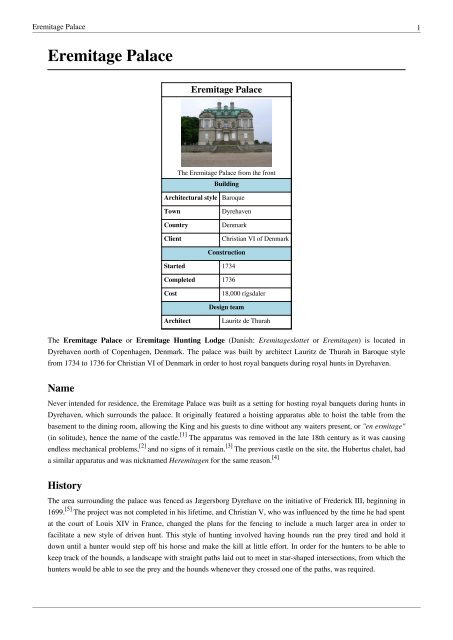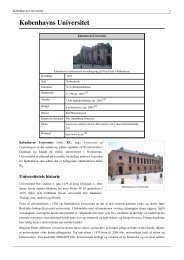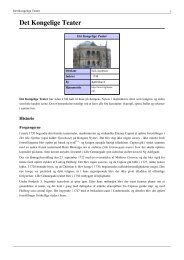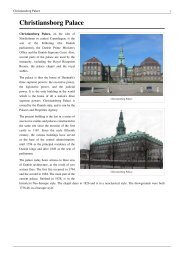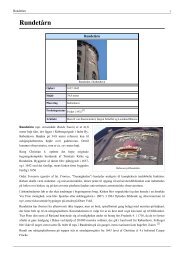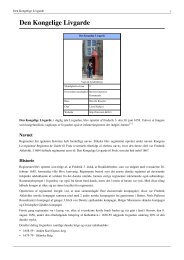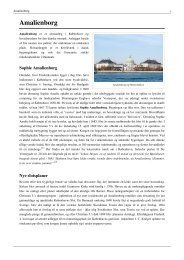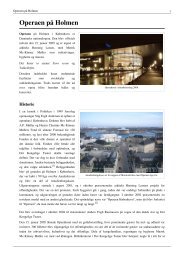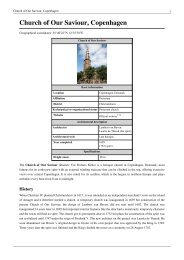Eremitage Palace - kaalund.nu
Eremitage Palace - kaalund.nu
Eremitage Palace - kaalund.nu
Create successful ePaper yourself
Turn your PDF publications into a flip-book with our unique Google optimized e-Paper software.
<strong>Eremitage</strong> <strong>Palace</strong> 1<strong>Eremitage</strong> <strong>Palace</strong><strong>Eremitage</strong> <strong>Palace</strong>The <strong>Eremitage</strong> <strong>Palace</strong> from the frontBuildingArchitectural style BaroqueTownCountryClientDyrehavenDenmarkChristian VI of DenmarkConstructionStarted 1734Completed 1736Cost18,000 rigsdalerDesign teamArchitectLauritz de ThurahThe <strong>Eremitage</strong> <strong>Palace</strong> or <strong>Eremitage</strong> Hunting Lodge (Danish: <strong>Eremitage</strong>slottet or <strong>Eremitage</strong>n) is located inDyrehaven north of Copenhagen, Denmark. The palace was built by architect Lauritz de Thurah in Baroque stylefrom 1734 to 1736 for Christian VI of Denmark in order to host royal banquets during royal hunts in Dyrehaven.NameNever intended for residence, the <strong>Eremitage</strong> <strong>Palace</strong> was built as a setting for hosting royal banquets during hunts inDyrehaven, which surrounds the palace. It originally featured a hoisting apparatus able to hoist the table from thebasement to the dining room, allowing the King and his guests to dine without any waiters present, or "en ermitage"(in solitude), hence the name of the castle. [1] The apparatus was removed in the late 18th century as it was causingendless mechanical problems, [2] and no signs of it remain. [3] The previous castle on the site, the Hubertus chalet, hada similar apparatus and was nicknamed Heremitagen for the same reason. [4]HistoryThe area surrounding the palace was fenced as Jægersborg Dyrehave on the initiative of Frederick III, beginning in1699. [5] The project was not completed in his lifetime, and Christian V, who was influenced by the time he had spentat the court of Louis XIV in France, changed the plans for the fencing to include a much larger area in order tofacilitate a new style of driven hunt. This style of hunting involved having hounds run the prey tired and hold itdown until a hunter would step off his horse and make the kill at little effort. In order for the hunters to be able tokeep track of the hounds, a landscape with straight paths laid out to meet in star-shaped intersections, from which thehunters would be able to see the prey and the hounds whenever they crossed one of the paths, was required.
<strong>Eremitage</strong> <strong>Palace</strong> 2The fencing of the larger area resulted in a compulsory relocation of the residents, and among other things the villageof Stokkerup was demolished, and today only the village pond remains, south of the palace.The first palace on the site, the Hubertus chalet (Danish: Hubertushuset), was built by Hans van Steenwinckel III forChristian V, and was completed around 1694. [4] It was a half-timbered house in two storeys, [2] but the structure wasmost likely far too weak, [6] and in spite of extensive repairs in 1731, the chalet was in such a poor condition in 1734that it was deemed necessary to tear it down and Lauritz de Thurah was hired to built a new palace on the site. [7] Thepalace was built during 1734 to 1736 during the reign of Christian VI at a total cost of about 18,000 rigsdaler. [8]The <strong>Eremitage</strong> <strong>Palace</strong> seen from the southeastA planned renovation in 1786 was cancelled, as the estimated cost of3,000 rigsdaler was considered too expensive. [9] In 1790 the decisionto tear the castle down was made, [9] but the decision was not popularamong everyone. Count Rantzau launched a defence of the palace andasked the king for permission to acquire it as his private property inexchange for Rantzau residence in Jægersborg and for giving the kingaccess to the palace. In 1794, the project succeeded, and Rantzau begana renovation of the palace at a cost of 4,000 rigsdaler. [3] It did not takelong for Rantzau to find the location of the palace inconvenient andremote, however. He decided to sell and by 1797 the palace was royalproperty again.In 1798, architect Johan Boye Junge Magens initiated yet anotherround of repairs, and in the process many of the exterior sculptures anddecorations were removed. Magens was, as fashion dictated, eager torid the building of the decorations that made it typical of its time. [10]In the early 19th century, after the Treaty of Kiel, Frederick VIchanged the use of Dyrehaven; the area was mainly used for militaryexercises. The palace was still in use, but mainly for lunches for theking and officers. When Christian VIII became king in 1839, the huntsresumed. Additionally, the palace became the centre of large, publicgatherings, and in this period it was often the site of politicalThe <strong>Eremitage</strong> <strong>Palace</strong> seen from eastnegotiations. On 5 June 1854 it was the center of the first, largecelebration of the Constitution of Denmark during which 30,000 people assembled in front of the palace. [11]During the 1890s, architect Ferdinand Meldahl supervised a thoroughrenovation taking great care to restore the original exterior decorationsof the palace. The interior decorations, which had been painted over,were cleaned up and renovated with an almost religious attention to theoriginal works. [11]Today the castle is run by the <strong>Palace</strong>s and Properties Agency, adepartment of the Ministry of Finance and is made available to theroyal family.External linksThe <strong>Eremitage</strong> during the 1890sGeographical coordinates: 55°47′43″N 12°34′16″E
<strong>Eremitage</strong> <strong>Palace</strong> 3References[1] Sestoft, Jørgen; Christiansen, Jørgen Hegner (1995) [1991] (in Danish). Guide til dansk arkitektur 1 - år 1000-1960 (2. edition ed.).Copenhagen: Arkitektens Forlag. pp. p. 107. ISBN 87-7407-158-0.[2] "The <strong>Eremitage</strong> Hunting Lodge" (http:// www. ses. dk/ 398955f0). <strong>Palace</strong>s and Properties Agency. 2005-12-01. . Retrieved 2007-03-25.[3] Christiansen, Torben (2005) (in Danish). Dyrehaven. Copenhagen: Politikens Forlag. pp. p. 158. ISBN 87-567-7250-5.[4] Bauditz, Ove (1936). "<strong>Eremitage</strong>n 1736-1936" (in Danish). Jagtslottet <strong>Eremitage</strong>n i Jægersborg Dyrehave 1736-1936. Copenhagen: DetBerlingske Bogtrykkeri. pp. p. 10.[5] Christiansen, p. 14.[6] Christiansen, p. 154.[7] Bauditz, pp. 26-27.[8] Bauditz, p. 30.[9] Bauditz, p. 49.[10] Christiansen, p. 159.[11] Christiansen, p. 161.
Article Sources and Contributors 4Article Sources and Contributors<strong>Eremitage</strong> <strong>Palace</strong> Source: http://en.wikipedia.org/w/index.php?oldid=339352442 Contributors: Cameron, Chin tin tin, Gryffindor, Hemmingsen, Hochstetler51, Jasper124c41, Killdevil,MisfitToys, Neddyseagoon, Neutrality, OrchWyn, Ramblersen, Stephen Hodge, 4 anonymous editsImage Sources, Licenses and ContributorsFile:The Hermitage <strong>Palace</strong>.jpg Source: http://en.wikipedia.org/w/index.php?title=File:The_Hermitage_<strong>Palace</strong>.jpg License: Creative Commons Attribution-Sharealike 2.0 Contributors:User:HemmingsenFile:<strong>Eremitage</strong>slottet and deers in Jægersborg Dyrehave.JPG Source: http://en.wikipedia.org/w/index.php?title=File:<strong>Eremitage</strong>slottet_and_deers_in_Jægersborg_Dyrehave.JPG License:Creative Commons Attribution-Sharealike 3.0 Contributors: User:Chin tin tinImage:<strong>Eremitage</strong>slottet_14-03-06_02.jpg Source: http://en.wikipedia.org/w/index.php?title=File:<strong>Eremitage</strong>slottet_14-03-06_02.jpg License: unknown Contributors: Geofrog,Kurpfalzbilder.de, Thomas81Image:<strong>Eremitage</strong>n 1895.png Source: http://en.wikipedia.org/w/index.php?title=File:<strong>Eremitage</strong>n_1895.png License: Public Domain Contributors: Theodor SierstedLicenseCreative Commons Attribution-Share Alike 3.0 Unportedhttp:/ / creativecommons. org/ licenses/ by-sa/ 3. 0/


